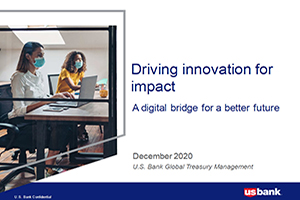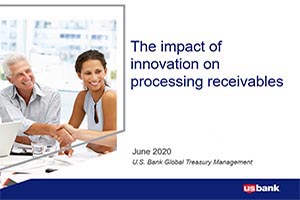Blockchain has gotten a lot of buzz in the last few years but getting banks and large companies to agree on data raises challenges. U.S. Bank separates the hype from substance through experiments like this.
By Christopher Swanson, Senior Vice President, U.S. Bank
Blockchain emerged ten years ago as the network architecture that facilitates exchange of the bitcoin cryptocurrency. It’s been touted as a potential solution to online privacy, inflationary monetary policy and even fake news.
U.S. Bank has been working with the technology for the last five years, primarily in the context of commercial banking, to make transactions between banks or between banks and corporate customers operate more efficiently. Today, banks and corporate firms maintain their own data for financial, trade and other value-based transactions and spend a considerable amount of resources reconciling differences between one another. In this context, blockchain provides a shared data layer that reduces the need for reconciliation. Think of it like an intercompany workflow/business process management solution.
So far, that use case seems promising: getting banks and large companies to agree on data is a big deal and the tech seems to do that. But it’s only solving for half the problem. A blockchain enforcing consensus on the data associated with a transaction is of limited value if the financial component of the transaction is conducted separately, off the blockchain. That reintroduces the possibility of disagreement on the data and the need for reconciliation that blockchain was supposed to eliminate.
To address that gap, we partnered up with Ivno, a company we met via the bank’s investment in R3, an enterprise blockchain firm. Ivno is working on creating cryptographic tokens backed by high-quality collateral designed for institutional use in regulated markets. These tokens are like bitcoin tokens, in that ownership and transmission are enforced via cryptographic processes, but different in that the value of bitcoin isn’t defined by another asset. The collateralization of the Ivno token allows it to be treated like cash, eliminating credit and counterparty risks.’’ This structure – and the accompanying transaction data on the blockchain - enables something called an atomic swap. This is where all parts of a transaction, including the financial component, are settled in a single event without an escrow service or financial intermediary.
To illustrate, suppose in today’s world, ABC Corporation wants to sell a bond to XYZ Asset Management. While that transaction appears to take place immediately, behind the scenes it takes three days to settle, as ABC Corporation and their bank need to make sure XYZ Asset Management has made the payment and XYZ Asset Management and their bank need to make sure ABC Corporation has delivered the bond. This requires a bunch of banks and securities clearinghouses to manage. Not very atomic.
Conversely, if both firms were transacting on the same blockchain network, ABC Corporation would be able to confirm XYZ Asset Management’s cash via a token like Ivno’s and XYZ Asset Management could confirm ABC Corporation’s ownership of the bond via its cryptographic signature on the blockchain. When both parties are ready, they execute the one transaction step of trading the token for the bond. Very atomic.
We’re still in the earliest days of blockchain and separating the hype from the substance is a big challenge. Through experiments like this, U.S. Bank is staying a step ahead and figuring out which blockchain applications will change the way we and our clients do business.
Learn more about business banking.
Ready to learn more? Swanson participated in a panel discussion on the practical applications of distributed ledger technology that you may find interesting.
Chris Swanson is a senior vice president at U.S. Bank who focuses on the research and development of blockchain and distributed ledger technology. He has more than five years of experience in distributed ledger strategy.




















































